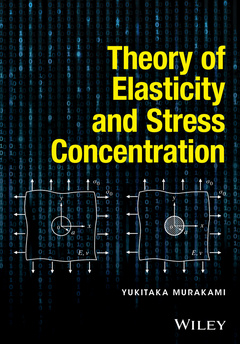Theory of Elasticity and Stress Concentration
Auteur : Murakami Yukitaka

Theory of Elasticity and Stress Concentration
Yukitaka Murakami, Kyushu University, Japan
A comprehensive guide to elasticity and stress concentration
Theory of Elasticity and Stress Concentration comprehensively covers elasticity and stress concentration and demonstrates how to apply the theory to practical engineering problems. The book presents a new approach to the topic without the need for complicated mathematics, and the principles and meaning of stress concentration are covered without reliance on numerical analysis.
The book consists of two parts: Part I - Theory of Elasticity and Part II - Stress Concentration. Part I treats the theory of elasticity from the viewpoint of helping the reader to comprehend the essence of it. Part II treats the principle and meaning of stress concentration and guides the reader to a better understanding of it. Throughout the book, many useful and interesting applications of the basic new way of thinking are presented and explained.
Key features:
- Unique approach to the topics.
- Encourages the readers to acquire the new way of thinking and engineering judgement.
- Includes examples, problems and solutions.
This book provides essential reading for researchers and practitioners in the structural and mechanical engineering industries.
Part I
Preface for the book
Preface for the part
Chapter 1 Stress
1.1 Stress at the surface of a body
1.1.1 Normal stress
1.1.2 Shear stress
1.2 Stress in the interior of a body
1.3 Two-dimensional (2D) stress state, three-dimensional (3D) stress state and stress transformation
1.3.1 Normal stress
1.3.2 Shear stress
1.3.3 Stress in an arbitary direction
1.3.3.1 Two-dimensional stress transformation
1.3.3.2 Three-dimensional stress transformation
1.3.4 Principal stresses
1.3.4.1 Principal stresses in two-dimensional stress state
1.3.4.2 Principal stresses in three-dimensional stress state
1.3.5 Pricipal shear stresses
Problems of Chapter 1
Chapter 2 Strains
2.1 Strains in two-dimensional problems
2.2 Strains in three-dimensional problems
2.3 Strains in an arbitrary direction
2.3.1 Two-dimensional case
2.3.2 Three-dimensional case
2.4 Principal strains
2.5 Conditions of compatibility
Problems of Chapter 2
Chapter 3 The Relationship between Stresses and Strains: The Generalized Hooke’s law
Problems of Chapter 3
Chapter 4 Equilibrium Equations
Problems of Chapter 4
Chapter 5 Saint Venant’s Principle and Boundary Conditions
5.1 Saint Venant’s Principle
5.2 Boundary conditions
Problems of Chapter 5
Chapter 6 Two-Dimensional Problems
6.1 Plane stress and plane strain
6.2 Basic conditions for exact solutions: Nature of solutions
6.3 Airy’s stress function
6.4 Hollow cylinder
6.5 Stress concentration at a circular hole
6.6 Stress concentration at an elliptical hole
6.7 Stress concentration at a hole in a finite width plate
6.8 Stress concentration at a crack
6.9 Stress field due to a point force applied at the edge of a semi-infinite plate
6.10 Circular disk subjected to a concentrated force
Problems of Chapter 6
Appendix of Chapter 6
Chapter 7 Torsion of a Bar with Uniform Section
7.1 Torsion of cylindrical bars
7.2 Torsion of bars having thin closed section
7.3 Saint Venant’s torsion problems
7.4 Stress function in torsion
7.5 Membrane analogy: Solution of torsion problems by using the deformation of pressurized membrane
7.6 Torsion of bars having thin unclosed section
7.7 Comparison of torsional rigidity between a bar with an open section and a bar with a closed section
Problems of Chapter 7
Chapter 8 Energy Principles
8.1 Strain energy
8.2 Uniqueness of the solutions of elasticity problems
8.3 Principle of the virtual work
8.4 Principle of the minimum potential energy
8.5 Castigliano’s theorem
8.6 The reciprocal theorem
Problems of Chapter 8
Chapter 9 The Finite Elemenet Method, FEM
9.1 FEM for one-dimensional problems
9.2 Analaysis of plane stress problems by the finite element method
9.2.1 Approximation of 2D plane stress problems by a set of triangular elements
9.2.2 Relationship between stress and strain in plane stress problemm
9.2.3 Stiffness matrix of a triangular plate element
9.2.4 Stiffness matrix of the total structure
9.2.5 Expression of boundary conditions and basic knowledge for element meshing
Problems of Chapter 9
Chapter 10 Bending of Plates
10.1 Simple examples of plate bending
10.2 General problems of plate bending
10.3 Transformation of bending moment and torsional moment
10.4 Differential equations for a plate subjected to loads on the surface and their applications
10.5 Boundary conditions in plate bending problems
10.6 Polar coordinate expression of the quantities of plate bending
10.7 Stress concentration in plate bending problems
10.8 Bending of a circular plate
Problems of Chapter 10
Chapter 11 Deformation and Stress in Cylindrical Shells
11.1 Basic equations
11.2 Various problems of cylindrical shells
Problems of Chapter 11
Chapter 12 Thermal Stress
12.1 Therrmal stress in a rectangular plate – Simple examples of thermal stress
12.2 Thermal stress in a circular plate
12.3 Thermal stress in a cylinder
Problems of Chapter 12
Chapter 13 Contact Stress
13.1 Two-dimensional contact stress
13.2 Three-dimensional contact stress
Problems of Chapter 13
Appendix
Appendix 1 Rule of direction cosines
Appendix 2 Green’s theorem and Gauss’ divergence theorem
Answers and Hints for the Problems
Since July 2006, under the auspices of the “Fundamental Research Project on Advanced Hydrogen Science”, a 7-year-long project adopted by NEDO, Professor Murakami has managed and pursued research on hydrogen and material property as the project leader in collaboration with National Institute of Advanced Industrial Science and Technology (AIST) and is tirelessly working toward the realization of a hydrogen society. His research interests are: strength of materials; metal fatigue; fracture mechanics; hydrogen embrittlement; stress analysis; and tribology. He has published 13 books and over 400 papers. He has been a Director of the Research Center for Hydrogen Industrial Use and Storage (HYDROGENIUS), National Institute of Advanced Industrial Science and Technology since July 2006. He is currently the Special advisor to Director of International institute for Carbon-Neutral Energy Research (I2CNER), Kyushu University. He has lectured Strength of materials, theory of Elasticity for undergraduate courses and Fatigue and fracture for post graduate. He has supervised more than 35 PhD students.
Date de parution : 11-2016
Ouvrage de 480 p.
16.8x24.6 cm


